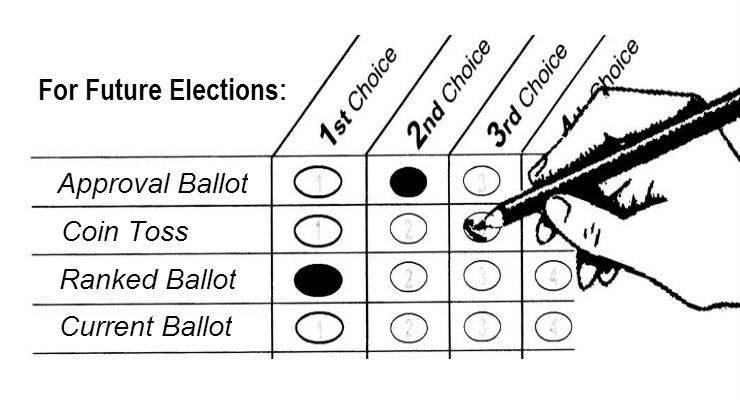
DIFFERENT VOTING METHODS SELECT DIFFERENT WINNERS FROM THE SAME MARKED BALLOTS!
Here’s a simple example:
Three candidates are running for the U.S. Presidency–candidates “A,” “B,” and “C.” Half the country loves candidate “A” but hates candidate “B”; the other half of the country loves candidate “B” but hates candidate “A.” EVERYONE, however, thinks of candidate “C” as their close 2nd choice.
Question Regarding Voting Methods:
In the best interests of our country, who do you think should be President–candidate “A,” “B,” or “C”? If you think you have the obvious answer, you’re not alone. But here’s the conundrum: OUR COUNTRY’S VOTING METHOD IS NOT THE OBVIOUS, BEST CHOICE(!). To prove it, let’s give our candidates here some realistic voting percentages. Let’s say:
- candidate “A” gets 49% of the votes
- candidate “B” gets 48%,
- and everyone’s close favorite 2nd choice, candidate “C,” gets the remaining 3%, but ALL of candidate C’s supporters prefer candidate “B” over candidate “A.”
And the WINNERS are:
- candidate “A” – via simple Plurality Voting (highest vote-getter wins–the basis of democracy in the USA since our country’s inception)
- candidate “B” – via Majority Wins, but when no majority, then a Runoff Vote–usually of just the top two vote-getters (as recently used in the disastrous Egyptian presidential election, and elsewhere); also via Ranked-Choice Voting [Instant Runoff Voting], where the least 1st-place vote-getter is dropped from the race, then the votes are re-tabulated, etc., until a first-place majority winner is found.
- candidate “C” – via rated-voting methods, such as Approval Voting (Approve of as many options as you like), or, even better, via Score Voting [aka Range Voting] (Score every option)–as used by internet/commercial reviews to indicate the options most likely to give the greatest overall satisfaction (but not utilized by any of the Free World’s self-serving politicians–in fear there’d be too many viable political competitors on a level playing field).
Sociological Conclusion:
Regarding voting methods, he best way for a group of people to make a collective decision in their society that will likely provide them with the greatest overall satisfaction is to utilize Score Voting.
George Sanders
VotingInSanity — a simple, not-for-profit, free, global humanitarian initiative
George@VotingInSanity.org
@VotingInSanity
P.S.:
Approval Voting can be initiated by officially adding just two more words to our ballot instructions: “Vote for one or more” (i.e.: remove the “overvote” rule).
Score Voting can be initiated and written in just two simple sentences, to be printed on every ballot–for example: “Voters can give a score from 0 to 100 to each and every candidate that they want (just like giving numerical grades on a school exam). Highest numerical total wins.”
Dale Sheldon-Hess says
Awesome; I’m a huge fan of approval (and also of score.)
Although I feel I should point out: All Condorcet methods and most Borda-style would also pick candidate C (although approval has certain other advantages over those methods.) Basically, every method _except_ plurality and instant-runoff/ranked-choice, would pick C. Which is why instant runoff is the worst possible voting method reform. ANYthing else could get this right.
Adrian Tawfik says
Why is instant runoff so bad? Some seem to love it.